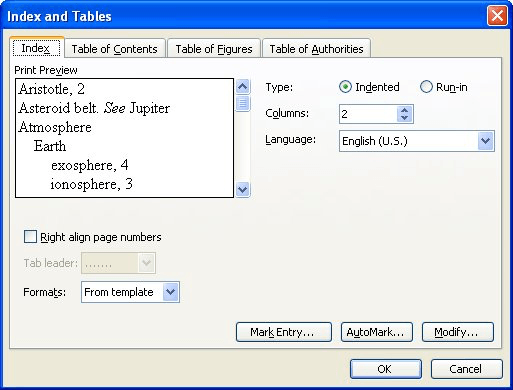Please Note: This article is written for users of the following Microsoft Word versions: 97, 2000, 2002, and 2003. If you are using a later version (Word 2007 or later), this tip may not work for you. For a version of this tip written specifically for later versions of Word, click here: Creating a Normal Index.
Written by Allen Wyatt (last updated December 15, 2018)
This tip applies to Word 97, 2000, 2002, and 2003
Once you have inserted all your index entries and subentries, as detailed in other WordTips, Word allows you to create a complete index by following these steps:

Figure 1. The Index tab of the Index and Tables dialog box.
Alternatively, you can follow these steps to create a normal index:
If you decide to use the index field to create your index, there are quite a few field switches you can use to control how Word creates the index. The most useful of these switches are discussed in other WordTips or in Word's Help system.
WordTips is your source for cost-effective Microsoft Word training. (Microsoft Word is the most popular word processing software in the world.) This tip (1902) applies to Microsoft Word 97, 2000, 2002, and 2003. You can find a version of this tip for the ribbon interface of Word (Word 2007 and later) here: Creating a Normal Index.

The First and Last Word on Word! Bestselling For Dummies author Dan Gookin puts his usual fun and friendly candor back to work to show you how to navigate Word 2019. Spend more time working and less time trying to figure it all out! Check out Word 2019 For Dummies today!
You've probably seen an index where an entry says something like "Obsidian: See igneous rock." This sort of ...
Discover MoreIt is not unusual to need to convert one notation in a document into another entirely different notation. For instance, ...
Discover MoreWord provides many options for creating indexes. One option allows you to specify that the index contain only entries ...
Discover MoreFREE SERVICE: Get tips like this every week in WordTips, a free productivity newsletter. Enter your address and click "Subscribe."
There are currently no comments for this tip. (Be the first to leave your comment—just use the simple form above!)
Got a version of Word that uses the menu interface (Word 97, Word 2000, Word 2002, or Word 2003)? This site is for you! If you use a later version of Word, visit our WordTips site focusing on the ribbon interface.
Visit the WordTips channel on YouTube
FREE SERVICE: Get tips like this every week in WordTips, a free productivity newsletter. Enter your address and click "Subscribe."
Copyright © 2025 Sharon Parq Associates, Inc.
Comments